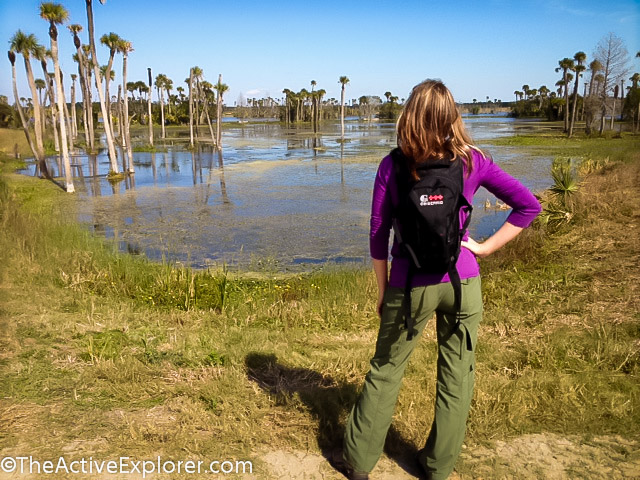The first time I hiked at the Orlando Wetlands Park it didn’t fully sink in that the area was actually a 1,220-acre wastewater treatment project. I mean, it’s absolutely gorgeous and full of wildlife. This visit, I grew more curious as I noticed culverts directing water flow from section to section. In another area, I saw what looked like a manmade spring welling up out of the ground. When I returned home I did some research. I’m going to quote from the public document I found rather than rephrase everything.
Source: The City of Orlando
Wetlands Operation
The Iron Bridge Regional WRF was constructed in 1979 by the City of Orlando with a mandate from the U.S.E.P.A. to consolidate several wastewater treatment facilities and to expand the available sewer capacity in the area. However, regional facility needed more effluent disposal capacity by the mid-1980s. An innovative solution to this situation was to develop a man-made wetlands system for the reuse of the highly treated effluent from the regional treatment facility. The City of Orlando purchased 1,650 acres in 1986 at a cost of $5,128,000 near Fort Christmas for this purpose. The 1,220 acre man-made wetland treatment system was completed in July 1987 with the conversion of the former pasture areas into wetlands.
The system was designed with a hydraulic capacity of 35 million gallons a day of reclaimed wastewater. The water is conveyed through a four-foot diameter pipeline approximately 17 miles to the influent distribution structure for the wetlands. Seventeen cells and three distinct wetland communities were created to remove residual amounts of nutrients, such as nitrogen and phosphorus, from the reclaimed water. The ecological communities include deep marsh areas, mixed marsh and wet prairie and hardwood – cypress swamps. The site planted with 2.3 million aquatic plants, including 200,000 trees, to create the man-made wetlands. A lake is contained within one of the cells.
The reclaimed water begins its 40-day journey through the Wetlands Park at the influent distribution structure, which is located near the western most edge of the property, just north of Wheeler Road, and in close proximity to the Influent Observation Deck. The reclaimed water meanders through the various habitats and eventually arrives at the two outfall structures for the wetland system. The flow leaves the Orlando Wetlands Park via a canal and flows into the St Johns River.
The function of the influent structure is to distribute the reclaimed water among the three flow paths through the wetland system. The reclaimed water flows first into the cells with the deep marsh habitat, which consists primarily of monocultures with either cattails or giant bulrush. Afterwards, the flow is routed through the mixed marsh and wet prairie cells containing thick growths of pickeralweed, duck potato and other aquatic shrubs. These areas are favored by the wading birds and migratory waterfowl. The final habitat in the wetland system is the hardwood swamp. Cypress, popash, tupelo and water hickories dominate within these cells. However, due to the constant high water levels, the trees have stunted growth and this habitat typically mirrors the deep marsh areas. A 100 acre lake is part of the central and southern flow paths through the wetland system.
The outflow is sampled every day and the results are reported to the Florida Department of Environmental Protection and the St. Johns River Water Management District. On average, the wetland system removes about 64% of the total nitrogen and approximately 74% of the total phosphorus in the reclaimed water. The wetlands outflow remains consistently lower than the background levels of phosphorus that are found in the St Johns River.
The park is highly popular with wildlife photographers and birders due to its amazing biodiversity. Local photography schools also host field trips to the park. During our visit I saw several camera lenses that likely required a second mortgage to buy. Most of the trails in the park are old roadbeds with only a few exceptions. This makes it easily accessible for people of all abilities and a good place to bring a bike. There are picnic and bathroom facilities near the entrance. The Orlando Wetlands Park is located at: 25155 Wheeler Road, Christmas, Florida, 32709. Keep in mind that the park shuts down from November 15th through January 31st of each year.

Flowers grow along the shore of the lake during spring. Just watch for snakes and gators in the weeds…







Comments 5
Thanks for posting this. When I lived on the east coast we used to ride our bikes at the Viera Wetlands in Melbourne. Now that we live in Orlando we will have to start ridding out here.
Safe travels,
Greg
Greg,
You won’t be disappointed as there are about six miles of trail there including a chunk of the Florida Trail that runs along the back of the park. Share pictures if you go!
Pingback: | Trail Ridge Outdoors
Erika,
Bill and I have been there and love it but we have not been there this year yet because they close from mid-November untill February. Will have to make the trip there again. Love hiking over there. Have you been to Viera Wetlands in Melbourne? It’s similar and you can drive around in the past but due to lack of fund to repair the road, they close past of it.
Your pictures are awesome!!!
Thank you so much Lek! I’ve never visited Viera wetlands, I should add it to my list. Hope to see you soon! Erika